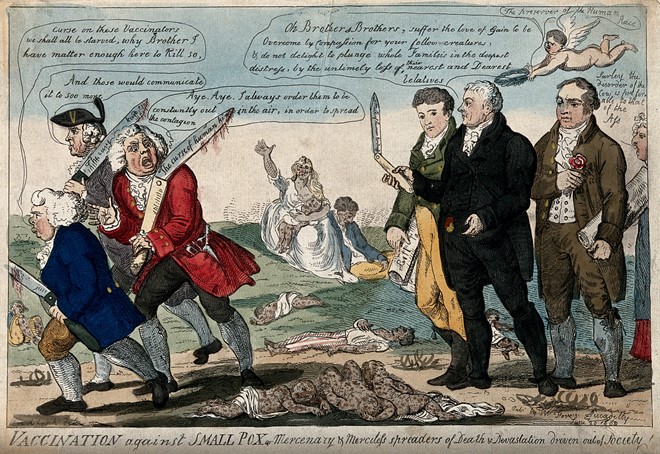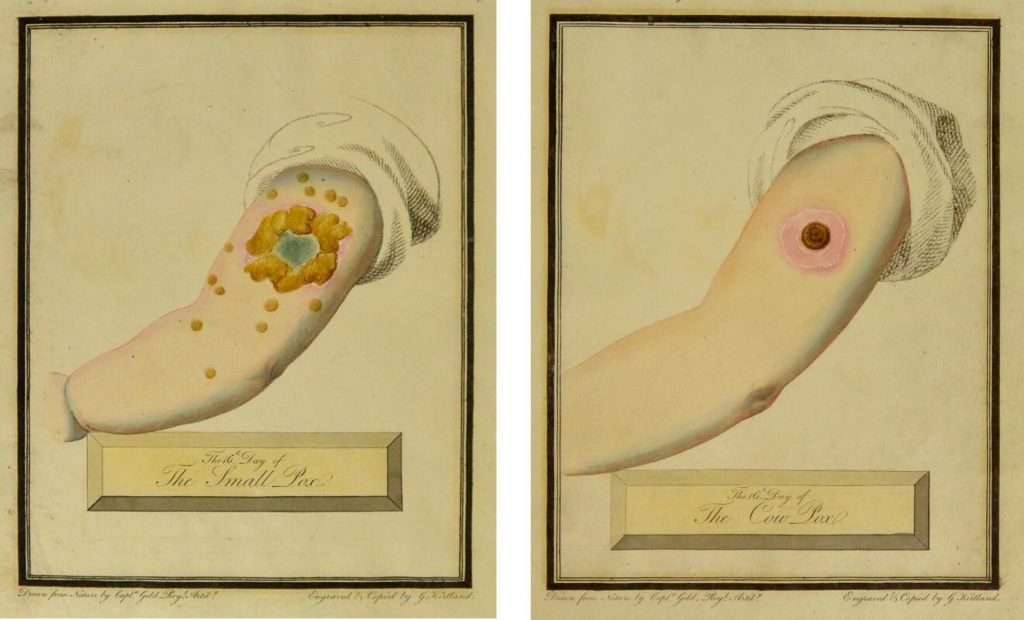Blog post researched and written by Spring 2021 HSHSL Intern, Hanna Takemoto. Hanna is a new graduate of the MLIS program at the University of Maryland, College Park. She recently completed an internship at the HSHSL where she worked on a collection of 19th century School of Medicine dissertations.
The Health Sciences and Human Services Library Historical Collections’ strives to provide broad access to our diverse collections both in person and digitally. Materials in our collections appear as they originally were published or created and may contain offensive or inappropriate language or images and may be offensive to users. The University of Maryland, Baltimore does not endorse the views expressed in these materials. Materials should be viewed in the context in which they were created.
As the world continues to grapple with the relentless coronavirus, vaccines remain the most promising tool in our arsenal. In fact, we are in the midst of what can be described as the most ambitious vaccination effort in human history. The unprecedented speed of the Covid-19 vaccine development has been a source of pride and hope, but also anxiety. According to the latest estimates by the U.S. Census Bureau, 15% of Americans do not plan on getting vaccinated against Covid-19. When we consider the successful vaccination campaigns of the 20th century that eradicated polio, tuberculosis, and measles, vaccine hesitancy may seem like a modern phenomenon fuelled by the online spread of misinformation. However, students at the University of Maryland’s School of Medicine were writing about vaccine hesitancy as early as 1825. In his dissertation titled “Vaccination”, soon-to-be Doctor of Medicine Robert Stuart McKaig argued that:
Although the history of vaccination has been but the history of its uniform and ascendant progress over all obstacles, whether of ignorance, prejudice or avarice, still there have always been those who, unwilling or unable to survey the whole subject, have preferred to rely on their own limited experience of a few doubtful cases and reject the boon of Jenner rather than yield assent to a mass of evidence such as has rarely, if ever, been accumulated in any other department of human investigation.

“The boon of Jenner” refers to the 1796 discovery of the smallpox vaccine by the English doctor Edward Jenner. Before its eradication in 1980, smallpox was one of the oldest and most deadly communicable diseases. The earliest evidence of a smallpox death dates back to 1157 B.C. and the fatality rate was between 25 and 30%. Those who survived were often left scarred or even blind.
Inoculation against smallpox had been common in China, the Middle East, and parts of Africa for centuries, and eventually made its way to Great Britain and New England. Variolous material from an infected person would be introduced into the body of a healthy one in order to induce a milder form of the disease and subsequent immunity. The practice reduced mortality rates significantly, but still carried the risk of severe infection. An 1835 graduate, Frederick Butler, wrote in “Inaugural Dissertation on Vaccination” that:
The lovely and fair still shuddered, lest theirs might be the countenance to bear the impression of deformity: and still willing to hold out their arm to the injecting puncture, rather than risk the danger of the natural disease.
Edward Jenner’s vaccine was safer because it used material from a cow infected with cowpox, a similar but much milder disease (the word vaccine is derived from the Latin word for cow, vacca). Frederick Butler explains:
It had been long observed before this discovery was made known, that certain persons connected with dairys [sic, dairies] in Great Britain were not susceptible of small pox, either natural or by inoculation. And also that these persons were previously affected with a singular kind of pustular soreness caught from milking cows whose udder exhibited the same pustular appearence. These facts were remarked as coincidency, yet no general inference had been drawn from them until Dr. Jenner, investigating the disease of the kine on the spot, came to the conclusion that this disease of the cow might be communicated and would secure the person who had received it from the action of small pox.
The smallpox vaccine was introduced to Baltimore in 1800 by John Crawford, a physician who briefly taught at the University of Maryland and whose book collection became the foundation for HSHSL.

Although Dr. Jenner was probably not the first person to try inoculation with the cowpox virus, his contributions were groundbreaking because he carefully formulated his hypothesis and tested it through well-documented experiments and observations. His approach was reminiscent of today’s evidence-based medicine and laid the foundations for the development of other effective vaccines. The following passage from Charles Wesley Parker’s 1828 essay “Cow-pox as a Preventive of Small-pox” rings remarkably true in 2021:
The discovery of a remedy in the prevention of so loathsome and fatal disease as that of small pox, may justly be ranked among the first in any age and in any science. In the preservations of human life, and in the alleviation of human suffering, this discovery stands unrivalled, and is justly entitled to be placed at the head of that long list of discoveries of which the medical profession can boast.
Indeed, the impressive efficacy of the smallpox vaccine, developed at a time when epidemiology was still in its infancy, is a testament to the power of immunization. Vaccines have saved millions of lives around the world and continue to protect our communities from dangerous diseases. We owe it to the vaccine pioneers, the future generations, and to ourselves to make good use of this discovery. To find a Covid-19 vaccine near you, go to: www.vaccinefinder.org
Sources and further reading
- Butler, Frederick. (1835). Inaugural Dissertation on Vaccination
- Esparza, J., Nitsche, A., & Damaso, C. R. (2018). Beyond the myths: novel findings for old paradigms in the history of the smallpox vaccine. PLOS Pathogens, 14(7). Available at http://hdl.handle.net/10713/8886
- Koplow, D. (2003). Smallpox : The fight to eradicate a global scourge. University of California Press.
- McKaig, Robert Stuart. (1825). An Inaugural Dissertation in English on Vaccination
- Parker, Charles W. (1828). An Essay on Cowpox as a Prevention of Smallpox
- Plotkin, S. A. (Ed.) (2010). History of vaccine development. Springer. https://doi.org/10.1007/978-1-4419-1339-5
- U.S. Census Bureau. (2021, April 14). Household Pulse Survey Covid-19 Vaccination Tracker

